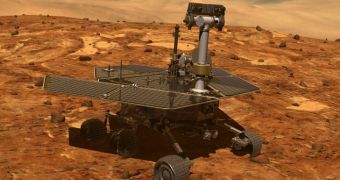According to NASA, the Opportunity rover, which landed on Mars in 2004 and which has been busy exploring this planet ever since, now holds the world record for the greatest distance to have until now been covered by a man-made machinery in an alien environment.
Thus, researchers who have been stalking it over the past few years say that, since it landed on the Red Planet until present day, this robotic rover successfully traveled over a distance of 25.01 miles (approximately 40.25 kilometers).
Commenting on the Opportunity rover's having successfully traveled over 25 miles on the Red Planet, John Callas with NASA's Jet Propulsion Laboratory in Pasadena, California, said, “Opportunity has driven farther than any other wheeled vehicle on another world.”
“This is so remarkable considering Opportunity was intended to drive about one kilometer and was never designed for distance. But what is really important is not how many miles the rover has racked up, but how much exploration and discovery we have accomplished over that distance,” he added.
In case anyone was wondering, the previous record for the greatest distance ever covered by a rover while exploring an alien environment was set by the Soviet Union's Lunokhod 2 rover several decades ago, back in the 1970s, Phys Org informs.
Thus, it was in 1973 that the Lunokhod 2 rover landed on our planet's moon, and successfully covered a distance of 24.2 miles (approximately 39 kilometers) in about 5 months' time. This achievement was documented with the help of images showing the rover's tracks on the moon.
“The Lunokhod missions still stand as two signature accomplishments of what I think of as the first golden age of planetary exploration, the 1960s and '70s,” said Steve Squyres of Cornell University in Ithaca, New York, and principal investigator for NASA's twin Mars rovers, Opportunity and Spirit.
Furthermore, “We're in a second golden age now, and what we've tried to do on Mars with Spirit and Opportunity has been very much inspired by the accomplishments of the Lunokhod team on the moon so many years ago. It has been a real honor to follow in their historical wheel tracks.”
NASA's Opportunity rover is now journeying along the western rim of an impact crater dubbed Endeavor. While exploring this region of the Red Planet, the robotic rover has uncovered traces of clay and sulfate-bearing minerals, astronomers say.
In the months to come, the rover should cover a distance of 26.2 miles (roughly 42.2 kilometers), and thus reach a site known as Marathon Valley. While here, Opportunity is to analyze soil samples and hopefully confirm suspicions that landscapes in this part of Mars are shaped by several clay minerals.

 14 DAY TRIAL //
14 DAY TRIAL //